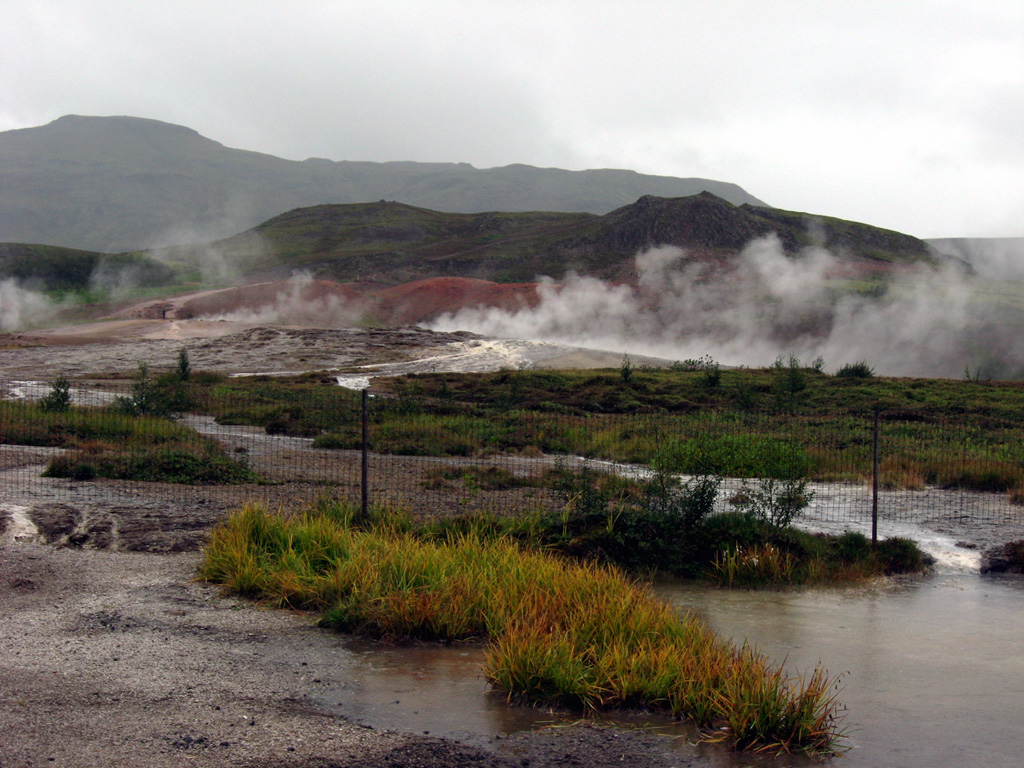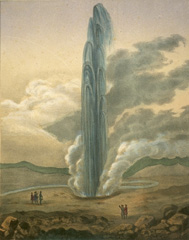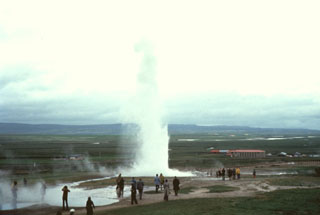

The Global Volcanism Program has no activity reports available for Geysir.
The Global Volcanism Program has no Weekly Reports available for Geysir.
The Global Volcanism Program has no Bulletin Reports available for Geysir.
This compilation of synonyms and subsidiary features may not be comprehensive. Features are organized into four major categories: Cones, Craters, Domes, and Thermal Features. Synonyms of features appear indented below the primary name. In some cases additional feature type, elevation, or location details are provided.
Cones |
||||
| Feature Name | Feature Type | Elevation | Latitude | Longitude |
| Bjarnarfell | Cone | |||
Domes |
||||
| Feature Name | Feature Type | Elevation | Latitude | Longitude |
| Laugarfjall | Dome | 187 m | ||
Thermal |
||||
| Feature Name | Feature Type | Elevation | Latitude | Longitude |
| Geysir | Geyser | 120 m | 64° 19' 0" N | 20° 18' 0" W |
| Haukadalur | Thermal | 120 m | 64° 20' 0" N | 20° 17' 0" W |
|
|
||||||||||||||||||
The Global Volcanism Program is not aware of any Holocene eruptions from Geysir. If this volcano has had large eruptions (VEI >= 4) prior to 12,000 years ago, information might be found on the Geysir page in the LaMEVE (Large Magnitude Explosive Volcanic Eruptions) database, a part of the Volcano Global Risk Identification and Analysis Project (VOGRIPA).
There is no Deformation History data available for Geysir.
There is no Emissions History data available for Geysir.
 The Strockur geyser is a prominent feature of the Geysir geothermal field, located south of Hveravellir central volcano. The volcano lies beneath the Langjökull icecap at the northern end of an active volcanic zone that extends to the NE from the Reykjanes Peninsula. Several shield volcanoes have been constructed along flank fissure zones, and postglacial lava flows flank Langjökull on the northern, western, and eastern sides. The massive Hallmundahraun lava flow, which covers 200 km2, was erupted shortly after 900 CE.
The Strockur geyser is a prominent feature of the Geysir geothermal field, located south of Hveravellir central volcano. The volcano lies beneath the Langjökull icecap at the northern end of an active volcanic zone that extends to the NE from the Reykjanes Peninsula. Several shield volcanoes have been constructed along flank fissure zones, and postglacial lava flows flank Langjökull on the northern, western, and eastern sides. The massive Hallmundahraun lava flow, which covers 200 km2, was erupted shortly after 900 CE.  The Geysir thermal area, containing Iceland's largest geysers, lies in the Haukadalur basin, just east of the southern end of the extensive Oddnyjarhnjukur-Langjokull volcanic system. Here a geyser can be seen ejecting water and steam to about 20 m high.
The Geysir thermal area, containing Iceland's largest geysers, lies in the Haukadalur basin, just east of the southern end of the extensive Oddnyjarhnjukur-Langjokull volcanic system. Here a geyser can be seen ejecting water and steam to about 20 m high. Iceland's largest geysers are located in the Haukadalur basin, part of the Geysir volcanic system, just east of the southern end of the Oddnyjarhnjukur-Langjokull fissure system. Here, the Strokkur geyser can be seen just as a burst of boiling water and steam erupts from a pool. This geyser erupts about every 10 minutes, producing a short-lived fountain that usually reaches about 20 m.
Iceland's largest geysers are located in the Haukadalur basin, part of the Geysir volcanic system, just east of the southern end of the Oddnyjarhnjukur-Langjokull fissure system. Here, the Strokkur geyser can be seen just as a burst of boiling water and steam erupts from a pool. This geyser erupts about every 10 minutes, producing a short-lived fountain that usually reaches about 20 m. Steam rises from the Geysir geothermal area with the rhyolitic Laugarfjall lava dome in the middle ground behind the mounds of reddish hydrothermally altered clays. The basaltic Bjarnarfjell complex lies on the horizon. The Geysir volcanic system lends its name to geysers around the world and is one of the most frequently visited geological sites in Iceland. No eruptions are known from this volcanic system during the Holocene, although geothermal activity continues and the Strokkur geyser is in almost continuous activity.
Steam rises from the Geysir geothermal area with the rhyolitic Laugarfjall lava dome in the middle ground behind the mounds of reddish hydrothermally altered clays. The basaltic Bjarnarfjell complex lies on the horizon. The Geysir volcanic system lends its name to geysers around the world and is one of the most frequently visited geological sites in Iceland. No eruptions are known from this volcanic system during the Holocene, although geothermal activity continues and the Strokkur geyser is in almost continuous activity.Maps are not currently available due to technical issues.
There are no samples for Geysir in the Smithsonian's NMNH Department of Mineral Sciences Rock and Ore collection.
| Catalogue of Icelandic Volcanoes (Link to Geysir) | The Catalogue of Icelandic Volcanoes is an interactive, web-based tool, containing information on volcanic systems that belong to the active volcanic zones of Iceland. It is a collaboration of the Icelandic Meteorological Office (the state volcano observatory), the Institute of Earth Sciences at the University of Iceland, and the Civil Protection Department of the National Commissioner of the Iceland Police, with contributions from a large number of specialists in Iceland and elsewhere. This official publication is intended to serve as an accurate and up-to-date source of information about active volcanoes in Iceland and their characteristics. The Catalogue forms a part of an integrated volcanic risk assessment project in Iceland GOSVÁ (commenced in 2012), as well as being part of the effort of FUTUREVOLC (2012-2016) on establishing an Icelandic volcano supersite. |
| Copernicus Browser | The Copernicus Browser replaced the Sentinel Hub Playground browser in 2023, to provide access to Earth observation archives from the Copernicus Data Space Ecosystem, the main distribution platform for data from the EU Copernicus missions. |
|
WOVOdat
Single Volcano View Temporal Evolution of Unrest Side by Side Volcanoes |
WOVOdat is a database of volcanic unrest; instrumentally and visually recorded changes in seismicity, ground deformation, gas emission, and other parameters from their normal baselines. It is sponsored by the World Organization of Volcano Observatories (WOVO) and presently hosted at the Earth Observatory of Singapore.
GVMID Data on Volcano Monitoring Infrastructure The Global Volcano Monitoring Infrastructure Database GVMID, is aimed at documenting and improving capabilities of volcano monitoring from the ground and space. GVMID should provide a snapshot and baseline view of the techniques and instrumentation that are in place at various volcanoes, which can be use by volcano observatories as reference to setup new monitoring system or improving networks at a specific volcano. These data will allow identification of what monitoring gaps exist, which can be then targeted by remote sensing infrastructure and future instrument deployments. |
| IRIS seismic stations/networks | Incorporated Research Institutions for Seismology (IRIS) Data Services map showing the location of seismic stations from all available networks (permanent or temporary) within a radius of 0.18° (about 20 km at mid-latitudes) from the given location of Geysir. Users can customize a variety of filters and options in the left panel. Note that if there are no stations are known the map will default to show the entire world with a "No data matched request" error notice. |
| UNAVCO GPS/GNSS stations | Geodetic Data Services map from UNAVCO showing the location of GPS/GNSS stations from all available networks (permanent or temporary) within a radius of 20 km from the given location of Geysir. Users can customize the data search based on station or network names, location, and time window. Requires Adobe Flash Player. |
| Large Eruptions of Geysir | Information about large Quaternary eruptions (VEI >= 4) is cataloged in the Large Magnitude Explosive Volcanic Eruptions (LaMEVE) database of the Volcano Global Risk Identification and Analysis Project (VOGRIPA). |
| EarthChem | EarthChem develops and maintains databases, software, and services that support the preservation, discovery, access and analysis of geochemical data, and facilitate their integration with the broad array of other available earth science parameters. EarthChem is operated by a joint team of disciplinary scientists, data scientists, data managers and information technology developers who are part of the NSF-funded data facility Integrated Earth Data Applications (IEDA). IEDA is a collaborative effort of EarthChem and the Marine Geoscience Data System (MGDS). |